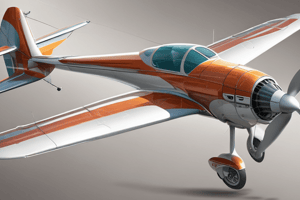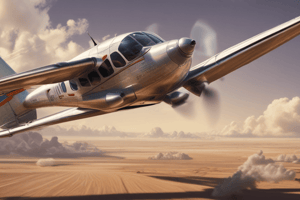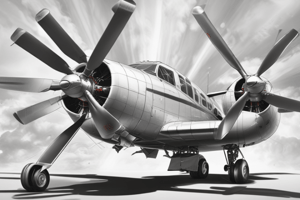Podcast
Questions and Answers
What is one advantage of propeller-driven aircraft regarding takeoff and landing?
What is one advantage of propeller-driven aircraft regarding takeoff and landing?
- They have longer takeoff distances.
- They offer lower speeds in flight.
- They are less expensive to maintain. (correct)
- They require more runway space.
For which application are new blade materials and manufacturing techniques highly beneficial?
For which application are new blade materials and manufacturing techniques highly beneficial?
- Helicopter rotors
- Gliders
- Jet engines
- Reciprocating engine installations (correct)
What is a key factor in the development of different types of propeller systems?
What is a key factor in the development of different types of propeller systems?
- Color of the propeller blades
- Type of fuel used
- Specific aircraft installation (correct)
- Weight of the aircraft
Which of the following best describes the design of a propeller blade?
Which of the following best describes the design of a propeller blade?
Why will many smaller aircraft continue to use propellers in the future?
Why will many smaller aircraft continue to use propellers in the future?
What is the power that the propeller converts into thrust horsepower?
What is the power that the propeller converts into thrust horsepower?
What is the typical range of propeller efficiency?
What is the typical range of propeller efficiency?
Which term refers to the ratio of thrust horsepower to brake horsepower?
Which term refers to the ratio of thrust horsepower to brake horsepower?
How is the efficiency of any machine defined?
How is the efficiency of any machine defined?
What is the primary goal of propeller design regarding power conversion?
What is the primary goal of propeller design regarding power conversion?
What does the symbol η (eta) represent in relation to propellers?
What does the symbol η (eta) represent in relation to propellers?
How is pitch related to blade angle in propellers?
How is pitch related to blade angle in propellers?
What is blade angle defined as in the context of propellers?
What is blade angle defined as in the context of propellers?
What does geometric pitch represent for a propeller?
What does geometric pitch represent for a propeller?
How is effective pitch different from geometric pitch?
How is effective pitch different from geometric pitch?
What is the formula to calculate geometric pitch?
What is the formula to calculate geometric pitch?
What does propeller slip indicate?
What does propeller slip indicate?
How can the chord line of a propeller blade be best described?
How can the chord line of a propeller blade be best described?
What characteristic describes a typical propeller blade?
What characteristic describes a typical propeller blade?
At what station is the radius R measured for geometric pitch calculation?
At what station is the radius R measured for geometric pitch calculation?
What happens to the effective pitch as the propeller experiences slippage?
What happens to the effective pitch as the propeller experiences slippage?
What is a primary drawback of pusher propellers compared to tractor propellers?
What is a primary drawback of pusher propellers compared to tractor propellers?
Which type of propeller system is considered the simplest?
Which type of propeller system is considered the simplest?
How are pusher propellers typically mounted on an aircraft?
How are pusher propellers typically mounted on an aircraft?
Why might pusher propellers experience damage during takeoff or landing?
Why might pusher propellers experience damage during takeoff or landing?
Which of the following represents a more advanced type of propeller system compared to fixed-pitch propellers?
Which of the following represents a more advanced type of propeller system compared to fixed-pitch propellers?
What is torque bending in relation to propeller blades?
What is torque bending in relation to propeller blades?
How does thrust bending affect propeller blades?
How does thrust bending affect propeller blades?
What is the primary action of aerodynamic twisting on propeller blades?
What is the primary action of aerodynamic twisting on propeller blades?
What does centrifugal twisting primarily do to the propeller blades?
What does centrifugal twisting primarily do to the propeller blades?
What happens to a propeller’s stresses as RPM increases?
What happens to a propeller’s stresses as RPM increases?
What serious consequences can nicks or scratches on a propeller blade lead to?
What serious consequences can nicks or scratches on a propeller blade lead to?
What role do the forces acting on the propeller's blades play at its low pitch position?
What role do the forces acting on the propeller's blades play at its low pitch position?
Where are the stresses on a propeller typically greater?
Where are the stresses on a propeller typically greater?
What percentage of torque is constituted by thrust in a propeller system?
What percentage of torque is constituted by thrust in a propeller system?
What happens to the horsepower required to turn the propeller as the blade angle increases?
What happens to the horsepower required to turn the propeller as the blade angle increases?
What are the two forces produced as an airfoil moves through the air?
What are the two forces produced as an airfoil moves through the air?
What effect does decreasing the propeller blade angle have on the propeller's speed?
What effect does decreasing the propeller blade angle have on the propeller's speed?
The most efficient angle of attack (AOA) for a propeller is typically how many degrees?
The most efficient angle of attack (AOA) for a propeller is typically how many degrees?
What happens if the engine is producing the same horsepower while the propeller blade angle is increased?
What happens if the engine is producing the same horsepower while the propeller blade angle is increased?
How does the actual blade angle necessary to maintain the efficient AOA change?
How does the actual blade angle necessary to maintain the efficient AOA change?
What function do lift versus drag curves serve in aerodynamics?
What function do lift versus drag curves serve in aerodynamics?
Flashcards
Advantages of propeller-driven aircraft
Advantages of propeller-driven aircraft
Aircraft powered by propellers offer several advantages, particularly during takeoff and landing. These include shorter take-off and landing distances, and lower maintenance costs.
Modern propeller advancements
Modern propeller advancements
Propellers have evolved significantly with new materials and designs. This has led to increased efficiency and made them well-suited for various applications, including turboprop and reciprocating engines.
Types of propeller systems
Types of propeller systems
Various propeller systems have been developed to suit different aircraft types, speeds, and operating conditions.
Components of a simple propeller
Components of a simple propeller
Signup and view all the flashcards
Aerodynamic cross-section of a propeller blade
Aerodynamic cross-section of a propeller blade
Signup and view all the flashcards
Thrust Horsepower
Thrust Horsepower
Signup and view all the flashcards
Brake Horsepower
Brake Horsepower
Signup and view all the flashcards
Propeller Efficiency
Propeller Efficiency
Signup and view all the flashcards
Propeller Slip
Propeller Slip
Signup and view all the flashcards
Propeller Pitch
Propeller Pitch
Signup and view all the flashcards
Blade Angle
Blade Angle
Signup and view all the flashcards
η (Eta)
η (Eta)
Signup and view all the flashcards
Propeller Efficiency Variation
Propeller Efficiency Variation
Signup and view all the flashcards
Geometric Pitch of a Propeller
Geometric Pitch of a Propeller
Signup and view all the flashcards
Effective Pitch of a Propeller
Effective Pitch of a Propeller
Signup and view all the flashcards
Chord Line of a Propeller Blade
Chord Line of a Propeller Blade
Signup and view all the flashcards
Propeller Blade Segments and Stations
Propeller Blade Segments and Stations
Signup and view all the flashcards
Twist of a Propeller Blade
Twist of a Propeller Blade
Signup and view all the flashcards
Chord of a Propeller Blade
Chord of a Propeller Blade
Signup and view all the flashcards
Propeller Rotation
Propeller Rotation
Signup and view all the flashcards
Torque Bending
Torque Bending
Signup and view all the flashcards
Thrust Bending
Thrust Bending
Signup and view all the flashcards
Aerodynamic Twisting
Aerodynamic Twisting
Signup and view all the flashcards
Centrifugal Twisting
Centrifugal Twisting
Signup and view all the flashcards
Blade Movement to Low Pitch
Blade Movement to Low Pitch
Signup and view all the flashcards
Stress on Propellers
Stress on Propellers
Signup and view all the flashcards
Impact of Blade Damage
Impact of Blade Damage
Signup and view all the flashcards
Stress and RPM
Stress and RPM
Signup and view all the flashcards
What is thrust in a propeller system?
What is thrust in a propeller system?
Signup and view all the flashcards
What is propeller blade angle?
What is propeller blade angle?
Signup and view all the flashcards
How does increasing blade angle affect propeller speed?
How does increasing blade angle affect propeller speed?
Signup and view all the flashcards
How does decreasing blade angle affect propeller speed?
How does decreasing blade angle affect propeller speed?
Signup and view all the flashcards
What is the most efficient angle of attack (AOA) for a propeller blade?
What is the most efficient angle of attack (AOA) for a propeller blade?
Signup and view all the flashcards
How does aircraft speed affect the required blade angle?
How does aircraft speed affect the required blade angle?
Signup and view all the flashcards
What is drag in the context of a propeller?
What is drag in the context of a propeller?
Signup and view all the flashcards
What is lift in the context of a propeller?
What is lift in the context of a propeller?
Signup and view all the flashcards
Pusher propellers: Damage risks
Pusher propellers: Damage risks
Signup and view all the flashcards
Types of propellers
Types of propellers
Signup and view all the flashcards
Fixed-pitch propellers
Fixed-pitch propellers
Signup and view all the flashcards
Ground-adjustable propellers
Ground-adjustable propellers
Signup and view all the flashcards
Constant-speed propellers
Constant-speed propellers
Signup and view all the flashcards
Study Notes
Week 1 Complete
- AVIA-1052 course is complete for Week 1
- Contact Matt C for corrections or improvements
Week 1 of 1 Day 1
- AVIA-1052, Week 1, Day 1 course content
Previously On AVIA-1052
- First class, no previous sessions
- Now this is first-class
Today On AVIA-1052
- Discussion of propellers
- Reviewing general propeller information
- Aircraft propeller theory
- Basic propeller controls
Where are we?
- Powerplant (Vol. 2) 7-2 to 7-6
- Start at General information
- Stop at Propeller Location
- FAA handbooks reference
Propellers
- The unit that absorbs engine power
- Propeller development
- Multiple stages of evolution
- Fabric-covered sticks, the first propellers
- Designed to push air backward
Powerplant 7-2
- Propeller started as a two-bladed wooden propeller
- Advancements have led to complex turboprop systems
- Variable-pitch, constant-speed feathering and reversing system
- Varying engine RPM to suit different conditions
- Increased efficiency when varying flight conditions
Constant-speed systems
- A flyweight-equipped governor unit
- Controls pitch angle of the blades to maintain constant engine speed
Normal propeller movement
- Different positions for low pitch, high pitch and feather when engine fails
- Zero to negative pitch into reverse pitch
Common Propeller Types
- Comparisons of propeller efficiency based on speed
Propellers (Further)
- Most propellers are two-bladed; great increases in power resulted in new designs
- Four- and six-bladed propellers
- Limited by revolutions per minute (RPM)
- Forces acting on the propeller as it turns: centrifugal force
- Tends to pull blades out of hub at high RPM
- Blade weight is critical for propeller design
- Excessive blade tip speed
- Rotating too fast may result in poor blade efficiency, fluttering, and vibration
- Aircraft speed limited by propeller speed
- Turbofan engines used for higher speeds
Propeller-driven aircraft advantages
- Easier and cheaper takeoff and landing procedures
- Less expensive maintenance
- Efficiency of propellers improved with new blade materials
Propeller Systems
- Many types of propeller systems have been developed for specific aircraft installations considering speed and operation type
Propeller Diagrams
- Basic nomenclature of parts of a simple fixed-pitch, two-bladed wood propeller
- Aerodynamic cross-section of a blade
- Terminology describing different blade areas
Aircraft Propeller Theory
- The aircraft propeller has two or more blades that are like rotating wings
- These blades produce forces that create thrust to push the airplane through the air
- The engine provides the power needed to rotate the propeller blades
Basic Propeller Principles (Mounted on Shaft)
- Low-horsepower engines use the crankshaft for propeller rotation
- High-horsepower engines use a propeller shaft coupled to their engine crankshaft for high-speeds The propeller transforms the engine's rotary power to thrust
Propeller Aerodynamic Process
- Airplanes experience drag during flight
- Thrust must be equal to drag to maintain level flight.
- Work done = thrust x distance
- Power = thrust x velocity
- Thrust horsepower is a measure of the power expended by thrust
Propeller Efficiency
- Propeller efficiency is the ratio of thrust horsepower to brake horsepower
- The efficiency of a machine is the ratio of its useful power output to its power input
- Propeller efficiency varies from 50 to 87% dependent on the amount of slippages during the process
Propeller Pitch
- Pitch is not equivalent to blade angle because pitch is determined by blade angle
- Increased / decreased pitch relates to increased / decreased blade angle respectively
Geometric Pitch
- Geometric pitch is the distance a propeller would advance in one revolution, with no slippage
- Calculated by a given formula
Effective Pitch
- Effective pitch acknowledges the slippage (difference) between geometric and effective pitch
The Chord Line
- Propeller blade's chord line is determined similar to airfoil chord line
- A propeller blade section is an airfoil section whose chord is the width of the blade section
Propeller Blade Parts
- Blade shank, thick and rounded, near the hub to support the blade
- Blade butt, also called the blade base or root, at the hub
- Blade tip, farthest from the hub, normally the last 6 inches of the blade
Propeller Forces
- Centrifugal force, tends to throw the rotating propeller blades outward away from the hub
- Torque bending, tends to bend propeller blades in the direction opposite of rotation
Propeller Excessive Blade Tip Speed
- Excessive blade tip speed can cause poor blade efficiency, fluttering, and vibration
Propeller Speed Limit
- Propeller-driven aircraft are limited to approximately 400 mph (644 kph)
Propeller Advantages
- Advantage of propeller-driven aircraft
- Takeoff and landing
- Cheaper maintenance
Many Different Propeller Systems
- Many types of propeller systems exist, specifically developed for specific aircraft setups
Basic Nomenclature of Propeller Parts
- Nomenclature of parts of a simple fixed-pitch, two-bladed wood propeller
- Aerodynamic cross-section of a blade, specific terminology defining areas such as chord line, blade face, and blade back
Propeller Systems, continued
- Various methods for changing speed and for adjusting propeller pitch
- Aircraft specific configurations
Propeller Governor Details
- A variety of devices and methods for controlling engine RPM and to maintain a consistent speed
- Constant speed propellers, used to ensure consistent speed
- Methods for monitoring RPM
Propeller Governor (Continued)
- Governor mechanisms, constant speed controls, and basic operational components
Types of Propellers
- Various types of Fixed-pitch propellers
- Ground-adjustable propellers
- Controllable-pitch propellers
- Constant speed propellers
- Feathering propellers
- Reverse-pitch propellers
- Propeller governor
- Details on the types of propellers
Propeller Location
- Tractor propellers
- Pusher propellers
Propeller Damage
- Pusher propellers are more susceptible to damage than tractor propellers, especially in land aircraft
Propellers Used in General Aviation Aircraft
- Fixed-pitch
- Ground-adjustable
- Controllable-pitch
- Constant-speed
- Feathering
- Reverse-pitch
- Propeller-governor
Metal Fixed-Pitch Propellers
- Metal versus wood
- Characteristics of the design
Hartzell Constant-Speed, Non-feathering
- Description of Hartzell constant-speed propeller design
Constant-Speed Feathering Propeller
- The various methods in use to control and adjust the speed of feathering propellers
Unfeathering
- Ways in which propellers can be unfeathered and the method required
Propeller Auxiliary Systems
- Ice control systems
- Anti-ice
- De-ice
Ice Control Systems
- How ice formation affects propeller performance
- Types of ice control systems
Deicing Systems
- Description of fluid and electric systems
Propeller Synchronization and Synchrophasing
- How a synchronization system works
- How it helps to prevent unwanted propeller vibration
Autofeathering System
- Autofeather systems assist propellers maintain a constant speed when engine power is lost
Propeller Inspection & Maintenance
- Important inspections to ensure that the propeller functions as intended
- Various tools for inspecting the different aspects of the propeller
- Various types of damage and how to look for it
Propeller Vibration Causes
- Various causes of vibration and how to troubleshoot them
Blade Tracking
- How blade tracking is done
- Explanation of how to inspect the blades and check for defects
Checking and Adjusting Propeller Blade Angles
- Procedures for checking and adjusting blade angles, including tools needed and proper usage
Universal and Digital Propeller Protractor
- Explanation and usage of the universal and digital propeller protractor
Propeller Balancing
- Static and dynamic balancing procedures
- Techniques and procedures necessary for achieving balance
Servicing Propellers
- General procedures and practices in maintaining and servicing propellers
Propeller Lubrication
- Lubrication procedures, including frequency and relevant information
Charging the Propeller Air Dome
- Procedures in ensuring a proper pressure for the propeller air dome
Propeller Overhaul Basics
- Overhaul procedures and how to approach the process
Propeller Reassembly
- Steps and procedures for reassembling parts after an overhaul occurs
Studying That Suits You
Use AI to generate personalized quizzes and flashcards to suit your learning preferences.




